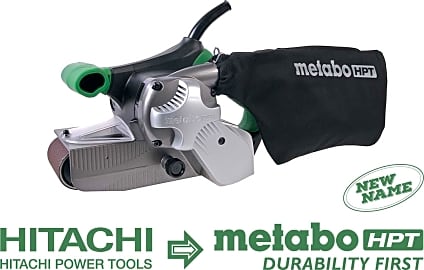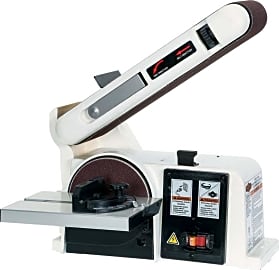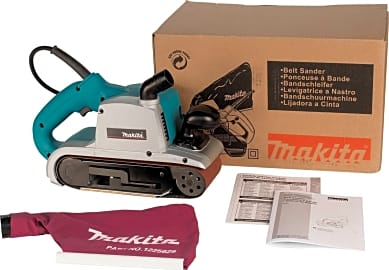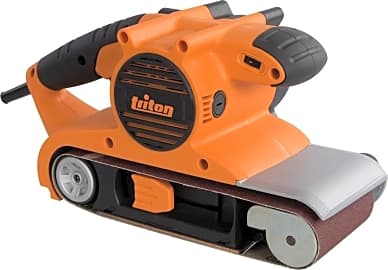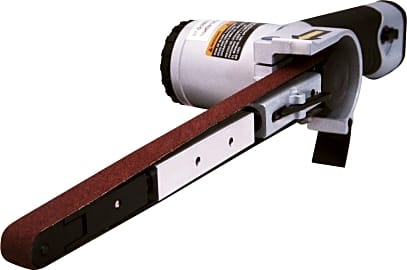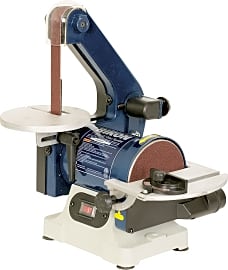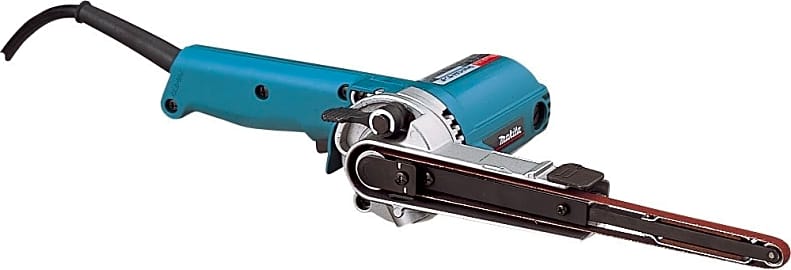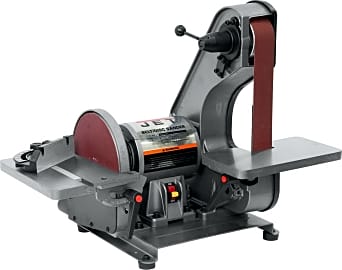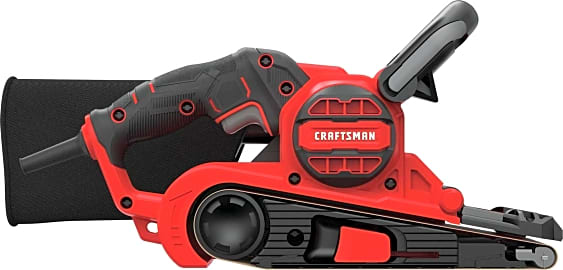The 10 Best Belt Sanders

This wiki has been updated 39 times since it was first published in March of 2015. Primarily used for large, flat surfaces, such as doors, tabletops, and decks, belt sanders are a powerful weapon in any handyman's arsenal that can remove large amounts of material in relatively little time. They can clean up welds, help you refinish outdoor furniture, and skim a fraction of an inch off any piece of lumber. Our picks include both portable and stationary models. When users buy our independently chosen editorial selections, we may earn commissions to help fund the Wiki.
Editor's Notes
November 02, 2020:
For this update, we removed the Skil Sandcat and Porter-Cable 352VS due to availability issues. We also removed the Grizzly G0547 due to complaints about its flimsy construction.
To maintain a variety of sander styles in our list, we added the RIKON Power Tools 50-151, a stationary machine, and the Triton T41200BS, a handheld opinion. Regardless of the type of belt sander you get, you'll need to practice proper maintenance to keep it running effectively. Always check the belt itself for any cracks or chips, and replace it if you find any. These small issues can turn into big problems if they damage or gouge the wood piece you're working on. After any sanding session, be sure to vacuum or blow out the entire unit with an air hose, to remove any dust that has collected during your project. Over time excessive dust can damage the internal components of the machine, and reduce its effectiveness.
Always be sure to observe all safety precautions when using a belt sander, as they can easily cause serious injury if not taken seriously. The torque created by the machine, as well as the rough surface of the sandpaper, can quickly pull in stray hair, jewelry, or loose clothing. They can also be extremely loud, so hearing protection is also recommended.
These machines will create a large amount of dust, so always wear a dust respirator, as well as proper eye protection. When changing belts, or doing any kind of maintenance on the sander, always make sure the machine is turned off and unplugged.
If a belt sander isn't precise enough for you, you might want to try one of these detail sanders. They won't be able to tackle large wood pieces like the belt sanders shown here, but their triangular shape makes them great for getting into small corners or sanding detail work. Or, if you're looking for something more mobile, one of these cordless sanders might be a better choice.
November 07, 2019:
Removed the Central Machinery Generic Mini, the Wen 6502, and the Wen 6321 because of quality concerns. Added the Shop Fox W1855, the Grizzly G0547, and the Craftsman CMEW213.
The Shop Fox and the Grizzly both have strong induction motors that are appropriate for running for long periods of time since they don't have brushes to wear out. The discs are quite useful and each uses heavy-duty bearings to ensure a long service life. An added bonus is that the belts they use are readily available in most hardware stores. The Makita 9903 is an excellent belt sander because it is powerful enough to use for stripping floors and also light enough to carry overhead.
Belt sanders are powerful tools that can grip and throw objects at high speeds. Safety glasses should be used in order to avoid personal injury. Breathing protection should be used, particularly when working with wood, to avoid inhaling hazardous dust.
A Short History Of Sand Paper
Human beings have understood the properties of abrasives for tens of thousands of years.
Human beings have understood the properties of abrasives for tens of thousands of years. There is plentiful prehistoric evidence of stone tools that have been precisely ground to hone an edge, and of early artwork and devotional figurines that have been polished and shaped using grinding materials. Early abrasion was usually performed with stone tools, but by the Chalcolithic era -- the first phase of the Bronze Age, metal tools were often also used to scrape and polish materials into their desired shape and finish.
The fist evidence of a precursor to modern sandpaper dates to around the first century of the Common Era. Archeologists have found evidence of Ancient Chinese craftsman using a mixture of ground shells, grains of sand, and hard seeds that were bound to a parchment backing using naturally occurring gums as an adhesive. The rough surface created was suitable for much the same use as modern sand paper, though it was much more complex and costly to produce. Natural materials such as shark skin were also used as abrasives in the ancient world.
It was not until the 19th Century, a time of leaps and bounds of technological progress, that a truly affordable and mass produced abrasive paper entered the marketplace. British inventor John Oakey is credited with having created the direct forebear of today's sand paper in the 1830s. His company produced a glass paper that consisted of "glass fit", a ceramic material, bonded to a paper backing and produced in large sheets.
Glass paper remains in use for much of the century. In the early 20th Century, developers working for 3M came up with a sandpaper made using silicon carbide grit as the abrasive. This remains a formula commonly used for sandpapers today. The backing used in sandpapers has continued to improve over the past few decades, with common materials in use today including thick papers, polyester, rayon, and other synthetic fabric-like materials.
Sandpaper with thick, durable backing is imperative for use with modern power sanders, and in particular with belt and bench sanders, which produce a surfeit of force. Great sandpaper paired with a great sander makes the job of the modern woodworker easier than his or her ancient predecessors could ever have imagined.
Choosing A Great Belt Sander
The term belt sander is something of a blanket expression that can be used to refer to many different power tools, the common thread being that they use a belt of sand paper that rapidly spins around drums which hold it taut. Some belt sanders are handheld, and are moved over the surface of the object to be smoothed. Others are larger and sit atop (or are affixed to) work tables; these units are usually called bench sanders. Still other large, industrial grade belt sanders are large enough to sit on the floor themselves.
Some belt sanders are handheld, and are moved over the surface of the object to be smoothed.
Choosing the right belt sander for your needs means carefully considering your line of work or your hobbies. For example, if you are a cabinet maker, a powerful bench sander might be a great choice, allowing you to quickly finish the surface of drawers and doors that will then be affixed to the frames you have designed. If you are a carpenter who builds or refinishes larger pieces of furniture -- those much too large to be maneuvered by hand -- then a handheld belt sander is a good choice, as you can move it around the large items on which you're working.
A belt sander packing plenty of power but that is still company enough for handheld use is also a great tool for anyone installing or refinishing a floor. Belt sanders can quickly strip away old varnish, stain, and damage, revealing lovely hardwood flooring that is ready to be refinished beneath the wear and tear.
Belt sanders can be used with a range of materials beyond woods, as well. Plumbers who need to polish the ends of PVC or metal pipes can easily do so with a belt sander and the right toughness and grit of paper, and a machinist of mechanic looking to remove bits of metal from a nut, bolt, or other component can do so quickly and deftly with a belt sander.
Proper Belt Sander Use And Maintenance
Belt sanders are powerful tools. If used improperly, can not only damage the item which you are hoping to build, restore, or improve, but they can cause serious bodily injury as well. Proper operation of a sander means proper attention to safety concerns.
If used improperly, can not only damage the item which you are hoping to build, restore, or improve, but they can cause serious bodily injury as well.
As a belt sander produces lots of dust, proper mouth and nose protection are essential; it is too easy in accidentally inhale the minute particles created by power sanding to risk doing so without protection your respiratory system. Protective eyewear is also highly recommended during operation of a belt sander, as the fine sawdust created can be a sever irritant, and as larger bits of material can occasionally be thrown upward by the sander. A sander should also be operated with gloves to prevent injury to the hands and fingers.
Even a great belt sander is only as effective as the sandpaper its user chooses. Select the right grit of sandpaper for the job at hand, remembering that the higher the grit number, the smaller will be the particles on the paper's surface, and thus finer the polishing job it can complete. (e.g., 1000 grit paper will sand more slowly but more precisely than 200 grit paper). Replace sandpaper often during the course of a job to ensure you are doing to best possible work.
Take the time to clean out your sander's exhaust port after each use, and make sure you wipe down any object to be sanded before you commence work to remove any material that is already loose on its surface.


